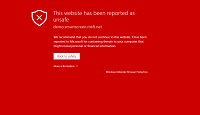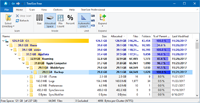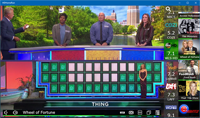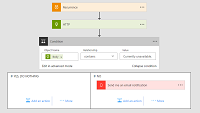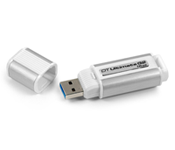 Windows To Go is a new feature of Windows 8 that allows enterprises to provision a full corporate environment that will boot from a USB drive. Once the instance of Windows 8 is booted it functions and is controlled by standard enterprise management tools such as SCCM and Active Directory group policies. Work at home and disaster recovery are the primary use cases as Windows To Go can transform any PC into a corporate PC with your application stack, all on a USB drive. Windows To Go is also perfect for trying out Windows 8 on your primary machine without destroying the native OS or building a home-use portable OS.
Windows To Go is a new feature of Windows 8 that allows enterprises to provision a full corporate environment that will boot from a USB drive. Once the instance of Windows 8 is booted it functions and is controlled by standard enterprise management tools such as SCCM and Active Directory group policies. Work at home and disaster recovery are the primary use cases as Windows To Go can transform any PC into a corporate PC with your application stack, all on a USB drive. Windows To Go is also perfect for trying out Windows 8 on your primary machine without destroying the native OS or building a home-use portable OS.
To begin you will need the following:
- 32 GB or larger USB 3.0 drive (It can also be an external USB Hard Drive). Some USB 2.0 drives will work but will be very slow and are not officially supported.
- A Windows 7 or 8 PC to build the USB drive on.
- Windows 8 DVD ISO.
Depending on the OS and edition you are currently running, follow the relevant instructions below.
Create Windows to Go on any edition of Windows 7:
It is possible to use Windows 7 to create your Windows 8 To Go USB device. You will just need some additional software. Before you get started, download and install the Windows 7 Automated Installation Kit. You will need to use ImageX to deploy the Windows 8 image to the device.
- Launch the Deployment Tools Command Prompt with administrative rights from the Start Menu. It can be found under All Programs and then Microsoft Windows AIK.
- Make sure that your USB Drive is plugged in and then type in diskpart and hit Enter.
- List the available disks by running "list disk" and you should see your usb device.
- Select your USB drive by typing "select disk #" and hit Enter. For example, “select disk 3”.
- Clean the partitions on the disk by typing "clean" and hit Enter.
- Now create the boot partition by running the following command:
create partition primary size=350 7. Now create the OS partition by running the following command to create a partition taking up all remaining space:
create partition primary 8. The boot partition needs to be formatted, configured and assigned a drive letter, run the following commands:
select partition 1
format fs=fat32 quick
active
assign letter=b
(if the b drive letter is already in use on your PC, substitute a different letter and replace b with your letter throughout the rest of this guide) 9. The same must be done for the OS partition, run the following different commands:
select partition 2
format fs=ntfs quick
assign letter=o
(if the o drive letter is already in use on your PC, substitute a different letter and replace o with your letter throughout the rest of this guide) 10. Exit Diskpart by typing Exit. 11. Extract the install.wim file from the \sources\ directory of the Windows 8 install ISO to c:\wim. You will need use a tool such as WinRAR or WinISO to extract the file if you don’t have a burned disc. 12. Use ImageX to deploy the Windows 8 files to the OS partition of the USB device by running:
Imagex.exe /apply c:\wim\install.wim 1 o: 13. The boot manager needs to be installed on the boot partition with the help of the bcdboot utility. Run the following command:
o:\windows\system32\bcdboot o:\windows /f ALL /s b: 14. Reboot your computer and test your new Windows 8 To Go device built on Windows 7. Make sure the PC is configured to boot to USB before your local hard drive.
Create Windows To Go on any edition of Windows 8:
- Launch an administrative level command prompt.
- Make sure that your USB Drive is plugged in and then type in diskpart and hit Enter.
- List the available disks by running "list disk" and you should see your usb device.
- Select your USB drive by typing "select disk #" and hit Enter. For example, “select disk 3”.
- Clean the partitions on the disk by typing "clean" and hit Enter.
- Now create the boot partition by running the following command:
create partition primary size=350 7. Now create the OS partition by running the following command to create a partition taking up all remaining space:
create partition primary 8. The boot partition needs to be formatted, configured and assigned a drive letter, run the following commands:
select partition 1
format fs=fat32 quick
active
assign letter=b
(if the b drive letter is already in use on your PC, substitute a different letter and replace b with your letter throughout the rest of this guide) 9. The same must be done for the OS partition, run the following different commands:
select partition 2
format fs=ntfs quick
assign letter=o
(if the o drive letter is already in use on your PC, substitute a different letter and replace o with your letter throughout the rest of this guide) 10. Exit Diskpart by typing Exit. 11. Extract the install.wim file from the \sources\ directory of the Windows 8 install ISO to c:\wim. On Windows 8 you can just double click an ISO to mount and then browse it. 12. Use DISM to deploy the Windows 8 files to the OS partition of the USB device by running:
dism /apply-image /imagefile:c:\wim\install.wim /index:1 /applydir:o:
13. The boot manager needs to be installed on the boot partition with the help of the bcdboot utility. Run the following command:
o:\windows\system32\bcdboot o:\windows /f ALL /s b: 14. Reboot your computer and test your new Windows 8 To Go device built on Windows 8. Make sure the PC is configured to boot to USB before your local hard drive.
Originally published 9/19/2011, updated 9/2/2012.
